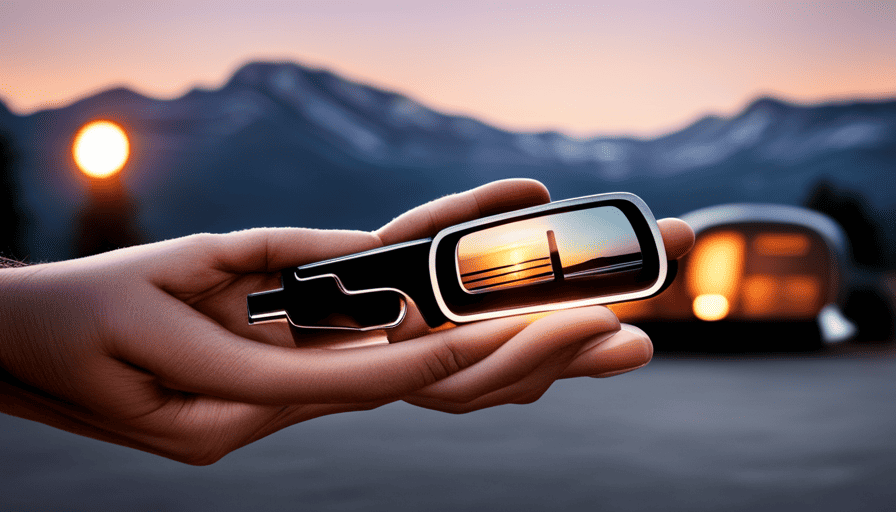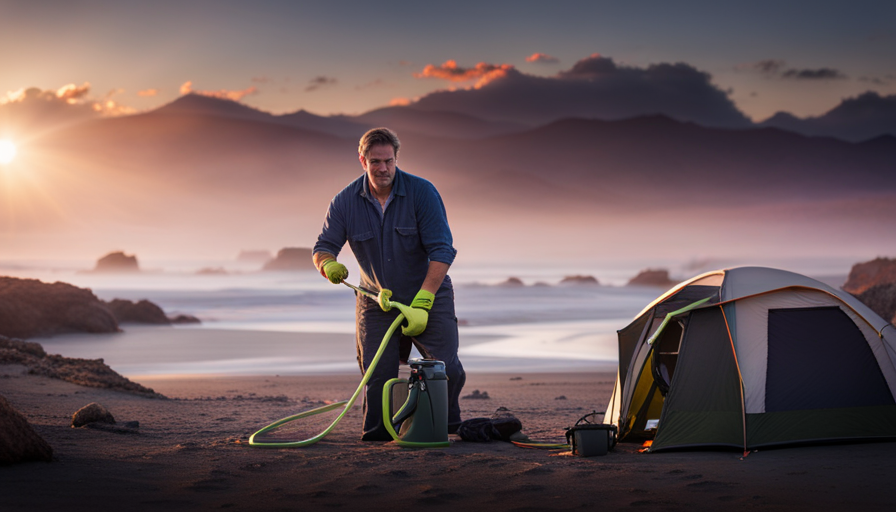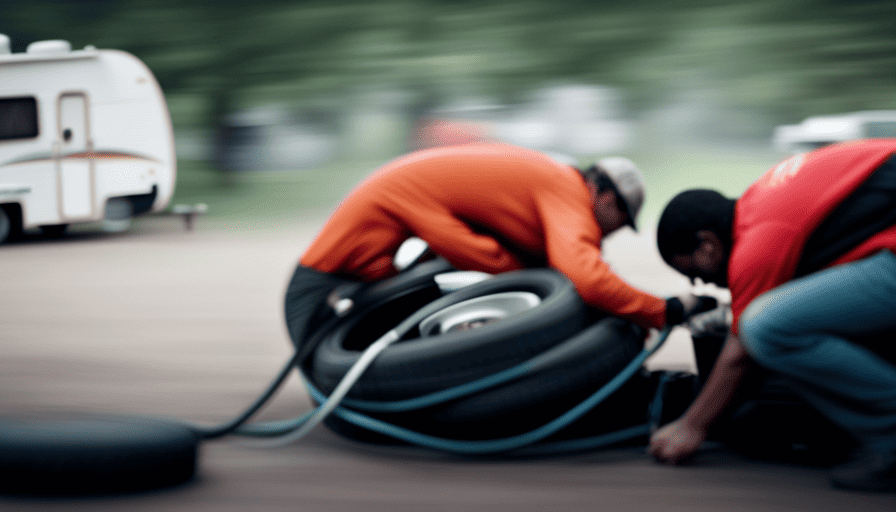Imagine stepping into your pop-up camper, looking forward to a weekend escape in the great outdoors, only to be hit with a strong musty smell right away. It’s like the scent of old socks and dampness has seeped into your temporary home.
But fear not, because I’ve got the solution to banish that unpleasant odor and restore freshness to your camper.
In this article, I will guide you through a step-by-step process to eliminate that musty smell from your pop up camper. From identifying the source of the odor to cleaning and disinfecting the interior, removing fabric items, using natural odor absorbers, and properly ventilating your camper, I’ve got you covered.
I’ll even share some clever tricks, like placing dryer sheets and coffee grounds in problem areas, using baking soda to absorb odors, and replacing or repairing moldy or damaged materials.
By following these practical tips, you’ll be able to enjoy your pop up camper without the unwelcome company of that musty smell.
So let’s dive in and get your camper smelling fresh and inviting once again!
Key Takeaways
- Proper ventilation and use of dehumidifiers are essential to prevent moisture buildup and musty smells in a pop-up camper.
- Regular inspection and cleaning with water and vinegar or mold-killing cleaner can help eliminate musty smells and restore freshness.
- Using natural odor absorbers like baking soda, activated charcoal, coffee grounds, vinegar, and essential oils can help remove musty odors from the camper.
- Cleaning and disinfecting the interior, removing and washing fabric items, and assessing and replacing moldy or damaged materials are important steps in getting rid of musty smells in a pop-up camper.
Identify the Source of the Smell
Now, take a moment to really focus your senses and locate the source of that pesky, musty smell that’s been haunting your beloved pop-up camper. As someone who’s experienced this issue before, I understand the frustration it can cause.
Luckily, there are a few things you can do to prevent musty smells in a pop-up camper. One of the most common causes of musty smells in pop-up campers is moisture buildup. When your camper is closed up for extended periods of time, humidity can accumulate, leading to that unpleasant odor. To prevent this, make sure to properly ventilate your camper whenever possible. Open windows and vents to allow fresh air to circulate. Additionally, using dehumidifiers or moisture-absorbing products can help reduce moisture levels inside the camper.
Another common culprit for musty smells is mold and mildew growth. These can thrive in damp environments, such as a closed-up camper. Regularly inspect your camper for any signs of mold or mildew, especially in areas prone to moisture, such as the bathroom or near sinks. If you do find any growth, clean it thoroughly with a mixture of water and vinegar or a mold-killing cleaner.
By taking these preventive measures, you can significantly reduce the chances of musty smells in your pop-up camper. Now, let’s move on to the next section and learn how to clean and disinfect the interior, ensuring a fresh and pleasant camping experience.
Clean and Disinfect the Interior
First, step inside your cozy home on wheels and embrace the challenge of transforming it into a fresh and inviting oasis. Cleaning and disinfecting the interior of your pop-up camper is essential to get rid of that musty smell. To make the process easier, I recommend using a variety of cleaning products or homemade cleaning solutions. Here is a table that showcases some effective options:
| Cleaning Product | Homemade Cleaning Solution | Benefits |
|---|---|---|
| All-purpose cleaner | Vinegar and water solution | Removes dirt and grime |
| Carpet cleaner | Baking soda and hydrogen peroxide paste | Eliminates odors and stains |
| Mold and mildew remover | Tea tree oil and water solution | Kills mold spores and prevents regrowth |
Using these cleaning products or homemade solutions, thoroughly clean every surface inside your pop-up camper, including the walls, floors, and furniture. Pay special attention to areas that are prone to moisture, as they are more likely to develop mold and mildew. Once you have successfully cleaned and disinfected the interior, you can move on to the next step of removing and washing fabric items to ensure your pop-up camper smells fresh and clean throughout.
Transitioning into the next section, let’s explore how to remove and wash fabric items to further eliminate any lingering odors.
Remove and Wash Fabric Items
To ensure a fresh and inviting atmosphere inside your cozy home on wheels, it’s time to tackle the task of removing and washing fabric items in your pop-up camper. Cleaning techniques and DIY solutions can help eliminate that musty smell and restore your camper to its former glory. Here are a few tips to get you started:
- Start by removing all fabric items, such as curtains, seat covers, and bedding.
- Check the care labels on each item to determine the appropriate washing instructions.
- Pre-treat any stains or spots before washing to ensure they come out completely.
- Use a mild detergent and wash the fabric items in cold water to preserve their quality.
Once you’ve completed this step, you’ll be amazed at the difference it makes in eliminating that musty odor.
Now, let’s move on to the next section where we’ll explore natural odor absorbers to maintain the freshness of your pop-up camper.
Use Natural Odor Absorbers
Once you’ve freshened up your cozy home on wheels by removing and washing fabric items, it’s time to discover the power of natural odor absorbers in maintaining a delightful atmosphere inside your pop-up camper.
Natural odor absorbers are a great way to eliminate musty smells and keep your camper smelling fresh and clean. One of my favorite natural odor absorbers is baking soda. It’s inexpensive, readily available, and highly effective at absorbing odors. Simply sprinkle some baking soda on carpets, upholstery, and any other areas that tend to hold onto odors. Let it sit for a few hours or overnight, then vacuum it up.
Another great natural odor absorber is activated charcoal. You can find small bags of activated charcoal designed specifically for absorbing odors. Place these bags in various areas of your camper, such as closets, cabinets, and under the sink. They’ll help absorb any lingering musty smells.
Additionally, you can make your own homemade air fresheners using essential oils. Mix a few drops of your favorite essential oil with water in a spray bottle and spritz it around your camper to add a pleasant scent.
By using these natural odor absorbers and homemade air fresheners, you can easily maintain a fresh and inviting atmosphere inside your pop-up camper.
Now, let’s move on to the next step and learn how to ventilate the camper to further eliminate any lingering odors.
Ventilate the Camper
In order to create a fresh and inviting atmosphere inside your cozy home on wheels, it’s important to ventilate the camper regularly to eliminate any lingering odors. Did you know that opening all the windows and roof vents for just 10 minutes a day can significantly improve the air quality inside your pop-up camper? By improving air circulation, you can effectively remove the musty smell that often plagues these small spaces.
Ventilation is key in preventing odors from becoming trapped and lingering in your camper. Fresh air helps to remove the stale and musty odors that can accumulate over time. Opening all the windows and roof vents allows for a continuous exchange of air, ensuring that any unpleasant odors are swept away.
Additionally, using dehumidifiers can also help in reducing the musty smell. Excessive moisture in the air can contribute to the growth of mold and mildew, which are common sources of musty odors. By using a dehumidifier, you can effectively remove excess moisture from the air, preventing the growth of these odor-causing culprits.
Incorporating these simple practices into your routine will not only improve the air quality inside your pop-up camper but also create a more pleasant and comfortable living environment. Now that we’ve discussed how to improve air circulation and reduce moisture, let’s move on to the next step: using odor eliminating sprays or air fresheners to further enhance the freshness of your camper.
Use Odor Eliminating Sprays or Air Fresheners
Enhance the freshness of your cozy home on wheels by incorporating odor eliminating sprays or air fresheners into your camper routine. When dealing with a musty smell in your pop-up camper, these products can work wonders in eliminating unpleasant odors and creating a more enjoyable living space.
Odor eliminating sprays are specifically designed to neutralize and eliminate odors, leaving behind a fresh and clean scent. Simply spray the product in the areas of your camper that are most affected by the musty smell, such as the cushions, curtains, and carpeting. Be sure to follow the instructions on the spray bottle for the best results.
Air fresheners are another effective option for combating odors in your pop-up camper. Choose a scent that you find pleasant and place the air freshener in a central location within your camper. This will allow the fragrance to disperse throughout the entire space, effectively masking any musty odors.
By incorporating odor eliminating sprays or air fresheners into your camper routine, you can easily freshen up the interior of your pop-up camper and eliminate any lingering musty smells. Once you’ve tackled this step, it’s time to move on to the next section and learn how to place dryer sheets or coffee grounds in problem areas.
Place Dryer Sheets or Coffee Grounds in Problem Areas
To truly transform the atmosphere inside your cozy home on wheels, there’s a simple trick that can work wonders – placing dryer sheets or coffee grounds strategically in problem areas. Here’s how to do it:
-
Dryer sheets: These little wonders not only leave your clothes smelling fresh, but they can also help eliminate musty odors in your pop-up camper. Simply tuck a few dryer sheets in drawers, cabinets, and any other areas where the smell seems to linger.
-
Coffee grounds: Coffee doesn’t just wake you up in the morning, it can also help tackle unpleasant odors. Fill a small bowl with coffee grounds and place it in the camper. The coffee will absorb the musty smell, leaving behind a pleasant aroma.
-
Using vinegar as a natural deodorizer: Vinegar is a powerful natural deodorizer that can help eliminate stubborn odors. Mix equal parts vinegar and water in a spray bottle and spritz it on problem areas. Let it sit for a few minutes before wiping it away.
-
Using essential oils to freshen the air: Essential oils, such as lavender or lemon, can add a refreshing scent to your pop-up camper. Mix a few drops with water in a spray bottle and spritz it around the living space. The oils will help freshen the air and mask any lingering musty odors.
By incorporating these simple tricks into your cleaning routine, you can effectively get rid of the musty smell in your pop-up camper. Now, let’s move on to the next step – using baking soda to absorb odors.
Use Baking Soda to Absorb Odors
Sprinkle some baking soda in problem areas to absorb any unwanted odors and create a more pleasant environment in your cozy mobile home. Baking soda is a fantastic odor absorber due to its natural properties.
However, if you don’t have any baking soda on hand, there are a few alternative DIY odor absorbers you can try. One option is to use activated charcoal, which works similarly to baking soda by absorbing and neutralizing odors. Another alternative is white vinegar. While it has a strong scent initially, it dissipates quickly and takes away musty smells. Simply place a bowl of vinegar in the problem areas and let it work its magic.
Additionally, you can create your own odor absorber by combining equal parts water and rubbing alcohol in a spray bottle. Spritz this mixture onto fabric surfaces such as curtains, cushions, and mattresses to eliminate odors. Remember to let the area dry completely afterwards.
Now, let’s move on to the next step and discuss how to replace or repair any moldy or damaged materials in your pop-up camper.
Replace or Repair Moldy or Damaged Materials
If you notice any moldy or damaged materials in your cozy mobile home, it’s essential to address and replace them promptly to maintain a clean and safe living environment. Mold and damaged materials not only contribute to the musty smell in your pop-up camper but can also pose health risks. Here are some tips on how to deal with moldy or damaged materials:
-
Assess the extent of the damage: Determine whether the material can be repaired or if it needs to be replaced entirely. Small areas of mold can sometimes be cleaned and repaired, but extensive damage may require replacement.
-
Remove and replace moldy materials: If you discover mold on fabrics, cushions, or other soft materials, it’s best to replace them entirely. Mold can penetrate deep into porous materials, making it difficult to fully remove.
-
Repair damaged materials: For materials that are only partially damaged, such as a damaged cabinet or wall panel, you can try repairing them. Use appropriate materials and techniques to ensure a proper fix.
By addressing moldy or damaged materials promptly and effectively, you can eliminate the musty smell and maintain a clean living environment in your pop-up camper.
Next, let’s discuss how to store the camper properly to prevent future odors.
Store the Camper Properly to Prevent Future Odors
Ensure you store your mobile home properly after use to prevent any future odors from occurring. Taking preventive measures and following a few long-term storage tips can help maintain a fresh-smelling pop-up camper.
Here are some practical ways to store your camper:
-
Clean and dry: Before storing your camper, thoroughly clean and dry all surfaces, including the fabric, cushions, and flooring. This will help prevent the growth of mold and mildew.
-
Ventilate: Ensure your camper is well-ventilated during storage. Leave windows and vents open to allow air circulation, reducing the likelihood of musty odors.
-
Use moisture absorbers: Place moisture absorbers, such as desiccant packs or moisture-absorbing crystals, inside your camper. These will help absorb any excess moisture and prevent mold growth.
By following these storage tips, you can minimize the chances of your pop-up camper developing a musty smell. Regularly inspect your camper during long-term storage and address any issues promptly. Taking these preventive measures will help ensure that your camper remains fresh and odor-free, ready for your next adventure.
Frequently Asked Questions
How often should I clean and disinfect the interior of my pop up camper to prevent musty smells?
I find that cleaning and disinfecting the interior of my pop-up camper regularly is key to preventing musty smells. To keep mold at bay, I follow a few simple tips.
First, I make sure to air out the camper after each use by opening windows and vents.
Additionally, I wipe down all surfaces with a mixture of vinegar and water to kill any mold spores.
Lastly, I keep moisture levels low by using dehumidifiers and silica gel packets.
These maintenance practices help me maintain a fresh-smelling pop-up camper.
Can I use regular household cleaning products to clean and disinfect the interior?
I always prefer using natural cleaning products when it comes to cleaning and disinfecting the interior of my pop-up camper. Not only are they effective, but they also have additional benefits. For instance, using vinegar as a cleaning agent not only removes dirt and grime but also helps eliminate odors. It’s a natural deodorizer that can tackle musty smells, leaving your camper smelling fresh and clean.
Plus, using natural cleaning products is better for the environment, making it a win-win situation.
Are there any specific types of natural odor absorbers that work best for removing musty smells from a pop up camper?
When it comes to removing musty smells from a pop up camper, there are several DIY methods that can be effective.
Natural odor absorbers, such as baking soda, activated charcoal, or white vinegar, work wonders in eliminating unpleasant odors. These options are not only chemical-free but also readily available and affordable.
Simply place them strategically around the camper, and they’ll absorb the musty smell over time.
How long should I ventilate the camper to effectively get rid of musty smells?
To effectively ventilate a pop-up camper and eliminate musty smells, there are a few key tips to follow. First, open all windows and doors to allow fresh air to circulate. Consider using fans or portable air purifiers to enhance airflow.
Additionally, leave the camper in a sunny spot, as sunlight helps to kill mold and mildew. To prevent musty smells during storage, thoroughly clean and dry the camper before closing it up, and use moisture-absorbing products like silica gel packets.
Are there any specific types of odor eliminating sprays or air fresheners that are recommended for use in a pop up camper?
When it comes to eliminating odors in a pop-up camper, I’ve found that using the right types of odor eliminating sprays and air fresheners can make a world of difference.
There are a variety of options available, but I recommend looking for odor eliminating sprays that specifically target musty smells.
As for air fresheners, opt for ones that are known for their effectiveness in neutralizing odors. Trust me, with the right products, you’ll have your pop-up camper smelling fresh and clean in no time.
Conclusion
In conclusion, I’ve found that getting rid of the musty smell from a pop-up camper isn’t as daunting as it may seem. By following the steps outlined in this article, you can successfully eliminate unpleasant odors and ensure a fresh and enjoyable camping experience.
Remember, just like a breath of fresh air on a spring morning, a well-maintained and odor-free pop-up camper can be a delightful retreat for any outdoor enthusiast. So don’t let the musty smell dampen your spirits. Take action and make your camper a home away from home.



















